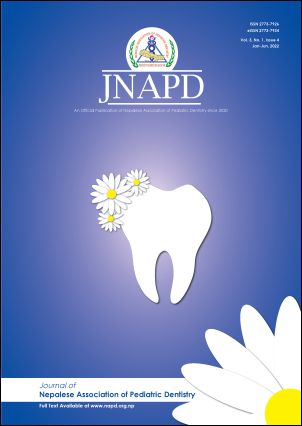Evaluation of Mineral Trioxide Aggregate and Biodentine as Direct Pulp-capping Agents in Human Teeth: An Ex-Vivo Study
DOI:
https://doi.org/10.3126/jnapd.v3i1.50059Keywords:
Biodentine, direct pulp capping, histology, MTA, pulp reactionAbstract
Introduction: Biodentine (Tricalcium Silicate based) is a modern bioactive cement that is comparable to the broadly utilized mineral trioxide aggregate (MTA). It has dentin-like mechanical properties, which can be considered appropriate material for diseased dentin-pulp complex recovery such as direct pulp capping. The present study was to compare the reaction of the pulp-dentin complex in human teeth after direct pulp capping with use of MTA and Biodentine.
Objective: To assess the histomorphologic response of human dental pulps on direct pulp capping with MTA and Biodentine.
Methods: Pulps of 34 maxillary permanent intact human third molars planned for extraction were mechanically exposed with sterile rotary round bur and allotted to one of the two exploratory groups, MTA or Biodentine. After four weeks, the teeth were extracted, stained with hematoxylin- eosin, and categorized by employing a preset histologic scoring framework. The histopathologic evaluations scored data were recorded and statically analyzed using SPSS where Mann-Whitney U test was used and p<0.05 was considered statistically significant.
Results: No inflammatory pulp reaction seen in 34 (100%) teeth whereas 19 (55.9 %) showed complete dentinal bridge arrangement. Layers of well-arranged odontoblast and odontoblast-like cells were found to make tubular dentin beneath the osteodentin. Inferential statistics using showed insignificance between the MTA and Biodentine test groups amid the perception period, showing similar outcomes.
Conclusions: Biodentine had comparative adequacy in the clinical setting and may be considered an appropriate alternative to MTA as the pulp- capping agent.
Downloads
Downloads
Published
How to Cite
Issue
Section
License

This work is licensed under a Creative Commons Attribution 4.0 International License.
This license enables reusers to distribute, remix, adapt, and build upon the material in any medium or format, so long as attribution is given to the creator. The license allows for commercial use.




